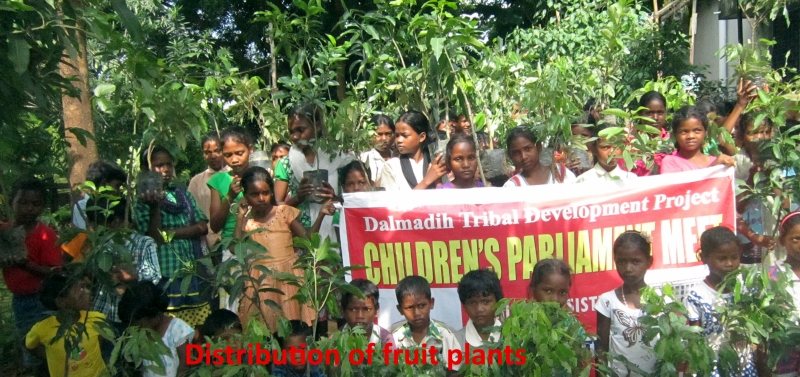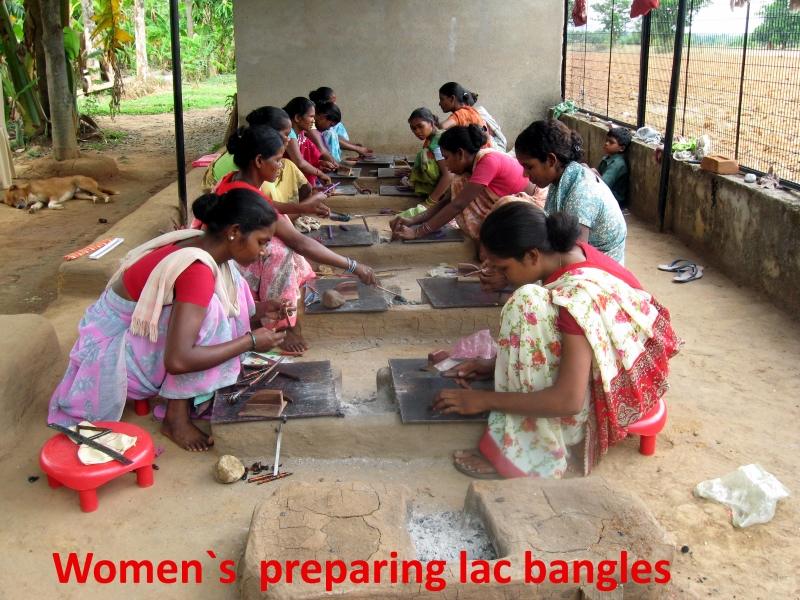DALMADIH - INDIA
- The main focus of our activities these years were to improve the capacity of our target group through various awareness programs, skill development programs, farm development, and on farm and off farm activities thus to improve their income earning capacity, to improve the life situation especially to improve the education of children and general health of the target group -

General information on the project and context
The project area is of 28 hamlets belonging to 9 villages in Gumla district which are inhabited predominantly by the tribal’s (more than 90%) like Khadia, Munda, Oraon, etc. The hamlets have a total population of 5,585 living in 1,089 households. Though each of the tribal groups speaks their own dialect, the common language for all of them is Sadri and Hindi.
About 58% of the target population is Christian. However, a significant proportion (38%) of the population does not have a formal religion. They continue to remain as the “nature worshipper” and referred to as “sarna”. The remaining 14% comprises mainly the Scheduled Castes. Though there is different religion it is not a barrier to function or mixing up in the villages. They all come together for meetings, celebrations, weddings etc.
Over 95% of the families are marginal farmers and they are mainly involved in farming depending on rain water. So they are able to cultivate only one crop by which they have to survive for one year. As the years goes rainfall is decreasing and the source of water is less. So it is necessary for the people to look for alternative means for their on farm activities as well as get involved in other activities where they can improve the income sources.
Objectives of the Project
 To increase income of the families.
To increase income of the families.- To reduce problems related to general health, reproductive health, malnutrition and disability.
- To improve situations with regard to education and vocational training.
- To organize community and strengthen the existing CBOs.
- To promote rights related to women, children, tribal’s, disabled, and their land.
- To preserve the tribal culture, promote cohesiveness and social defense.
- To promote gender equity.
- To address issues related to climate chang.
1. the result
The main four components such as education, community based organization, health and nutrition and livelihood activities are the areas that we could focus and improve in their lives.
A) EDUCATION
The enrollment in the schools as well as in Aganwadies has improved and the number of children enrolled this year is 1408 from our project area. The tuition centres are a means for the disadvantaged children to pursue their study. This year we have 10 centres and 202 students are benefiting the major aspects of Holistic approach .The Meetings and discussions with parents have made them to become responsible. The emphasis and opportunity given for vocational and Gragani (Home care) training by the project reduced the unskilled labour force. Six youth were given training for tailoring ,carpentry and driving. Parents became aware of the need for quality education and the 11 parents taking the trouble to send their children to English medium with better opportunities among which three are our sponsored children. It is very remarkable for this remote village. 10% of the children are sent to residential school for quality education. The performance of the children also are improving.
B) HEALTH & NUTRITION
Special efforts was taken for promoting preventive health care and is committed to improve the health and nutrition of children and women with special focus on the reduction in Infant Mortality Ratio(IMR) and Maternal Mortality Ratio (MMR). We are very happy to witness 62 mothers with safe delivery and healthy children. There was no case of IMR and MMR. We also motivated the mothers for immunization and the report shows that 100% children received immunisation. A special eye check up was conducted which is only a dream for our target group. Regular medical check up was conducted for the children to identify infectious diseases among children.
C) COMMUNITY BASED ORGANISATIONS
Among the various community development groups, the contribution of women is very outstanding for the development of their villages, families and of their children. Through various interventions they realised that economic independence is one of the means for overall development. Thus this motivated them to save money, take loan for immediate needs of the family and start small scale business to increase income of the families. Many women have stories today to say how they have come out of the exploitation by the money lenders. This made difference in the life of the children to be safe, educated and healthy. The 21 children’s parliament made a difference in the life of the children especially to know their rights and how to exercise them. The farmers group, Village development committee, Youth group made an impact to the development of the society. The interaction with the parents made them to be more responsible and caring for their children. They also gather to discuss and share their views on climate change fluctuation and cropping methods. This has helped them to have 20% increase in their production.
D) LIVELIHOOD INTERVENTIONS
Self Help Group and five individuals got financial assistance to start income generation activities such as hotels, petty shops, pottery etc... The motivation given to children to start kitchen garden was a remarkable change to augment their dietary intake while some of the families made profit by selling vegetables in the markets. The distribution of agro -equipment like Tulu pump has helped 23 farmers this year to earn extra income by vegetable cultivation. The watershed activities such as farm bund farm pond, introduction of bio fertilizers, pesticides and plantation of trees has helped 182 farmers to save natural resources as well as improve their production to sustain their life. As migration is one of the social problems we see, this year we took special effort to convince people through awareness programs the effect of migration in the life of the society and encouraged people to begin off farm activities as well as vegetable cultivation using the water sources available. This has helped people to improve their income.
2. VARIOUS TRAINING PROGRAMMES ORGANIZED FOR THE VILLAGERS
Communication skills, Moral values, Tips for successful life, Concept of Rural management, Leadership, Right Based Approach, Immunisation and early child care, Parenting, Malnutrition, First aid, Monitoring and evaluation.
3. NETWORKING
We are in collaboration with some of the agencies known to us like NABARD, TRIFED, Gram udhan, SIGN, CHABIJAN, Gurukul etc. Women and Child Development Officer continue to extend her support to the project, and local Government officials and Block Office, United Bank, the local Primary Health Centre in matters of health for referral cases. Besides these, we have contact persons who give training to the Teachers, Field Staff, Farmers, Youth, Children and SHGs.
4. INCIDENTS RELATED TO THE ANTI-CORRUPTION AND CHILD PROTECTION CODICES
The children’s parliaments are taking lot of initiative to prevent dropouts so as to prevent trafficking of girls. Since the parents are illiterate they come in the trap of agents for so called job in Delhi and other cities. Now our children parliament members are aware and such cases arrives they take initiative to protest and if it is beyond their capacity they inform the elders who can get involved.
5. Monitoring and evaluation
The project team visit villages regular basis to monitor the activities and report to the office once a week. The project managing committee takes interest to evaluate the performance of the staff occasionally as well as staff assessment is done by project in charge. We also conduct sector level evaluation to know the views of the people as well as to build rapport with them. Yearly evaluation is conducted with staff as well as with village development committee.
PHOTO ALBUM...


 EN
EN  ES
ES  FR
FR 



